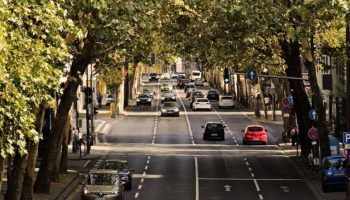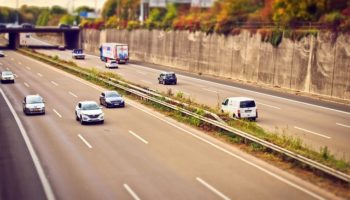What is a Diamond Lane?
Diamond lanes are reserved lanes for carpools, vanpools, buses, motorcycles, or any vehicle carrying two or more people. Commonly they are also known as High-occupancy vehicles (HOV) or carpool lanes. They work on the ideology to maximize the movement of people rather than vehicles.

The Design Criteria for Diamond Lane:
There is a lot of planning involved to operate and implement Diamond lane in an area. Here are some important criteria for introducing them in a location:
- The best potential area for HOV lanes is where a network of special-use highway lanes are connecting major population and employment centers.
- They can also be introduced in a single traffic lane within the main roadway with different markings in the area. In these cases, they may operate as a reversible lane, working in the direction of the dominant traffic flow in both the morning and the afternoon.
- They can also be a separate roadway with one or more traffic lanes. They can be parallel to the general lanes and separated by grades. This is because the traffic speed is different between HOV and general lanes. Therefore, it can create a dangerous situation if they avoid separation by a barrier.
- HOV bypass lanes can allow carpool traffic and police in the areas of regular congestion.
- It’s important to avoid empty lane syndrome. This occurs when people are in a traffic jam and they don’t see enough vehicles using the empty dedicated bus lane next to them. Hence in frustration, they illegally jump into the HOV lane. To avert this situation, the number of buses and cars using the HOV lane should meet a decent number.
- A systematic development for HOV lanes will help to strengthen the whole system. Like introducing parking for carpools, improved bus service, park and ride lots, employer-based incentives, and ride-matching.
- Diamond lanes require a thoughtful analysis on a case-by-case basis. Also, there is no correct design. They can be proposed for almost every configuration and set of operating rules depending on the location.
Advantage of Diamond Lane:
- The potential areas for the Diamond lanes are those that have recurring traffic congestion. The introduction of the facility will offer travel time savings.
- Research says that HOV lanes promote traveling together. Hence, this will help to reduce the emission of greenhouse gases and air pollution in the transportation industry.
- These lanes result in an improvement of the people-moving.
- It is cost-effective and physically feasible to implement a safe, accessible facility for the public.

Evolution of Diamond Lane in Different Countries:
United States: These lanes were introduced In the United States, during the 1970s and early 1980s. It progressed rapidly from the mid-1980s to the late 1990s. They introduced the first High Occupancy Vehicle lane in the Henry G. Shirley Memorial Highway in Northern Virginia. It opened in 1969 as a bus-only lane. Later in 1973, it became operational to carpools with four or more occupants. It was the first time in which buses and carpools officially shared an HOV lane.
Canada: In the early 1990s, Canada started introducing HOV lanes in Greater Vancouver and Toronto. Later it was followed in Ottawa, Gatineau, Montreal, and Calgary. By 2010, there were about 150 km of HOV lanes in 11 different locations of British Columbia, Ontario, and Quebec. Moreover, Canada has more than 130 km of arterial HOV lanes in 24 areas located in Greater Vancouver, Calgary, Toronto, Ottawa, and Gatineau.
Europe: The first country to adapt to the diamond lane in Europe was the Netherlands. The lane started in October 1993 and operated until August 1994. Although it did not attract enough users. Hence it got convert into a reversible lane that became open to general traffic. This happened after a judge took action in a legal test case. He ruled that Dutch traffic law lacks the concept of a carpool. Thus it was inducing violation of the principle of equality.
There are a few HOV lanes in operation on the continent. This is mainly because European cities have good public transport services and fewer high-capacity multi-lane urban motorways in comparison to the U.S. and Canada. However, there is an emphasis on providing bus lanes and on-street bus priority measures.
Oceania: The HOV lane is also known as a Transit Lane- T2 or T3 in Australia. It opened in February 1992 on the Eastern Freeway in Melbourne. Now there are T2 and T3 facilities in Canberra, Sydney, and Brisbane.
In New Zealand, there are many short HOV 2+ and 3+ lanes throughout the region. They are commonly known as T2 and T3 lanes similar to Australia. Although, in a one-year trial eleven lanes were open to electric vehicles from September 2017.
How has this Successfully worked in practice?
The high Occupancy Vehicle lanes concept gained a lot of attention. Therefore, the idea is welcomed globally. Here are some examples that proved to be successful:
- N-VI, Madrid, Spain: There was an increase in the usage of Public transport mode from 23.5% to 34.8% after implementation. Also, single occupancy vehicle use on N-VI dropped from 70% to 48%.
- I-5 in Portland, OR, US: HOV lane carries 33% more people than the adjacent general lane.
- Barnet-Hastings Highway, Vancouver BC, Canada: HOV lane increased the Average Vehicle Occupancy (AVO) from 1.22 to 1.35 persons per vehicle in the AM peak hour. Therefore, increasing the person carrying capacity of the highway by 11%.
- Long Island Expressway, NY, US: After 6 months of its existence, the Average Vehicle Occupancy increased from 1.14 to 1.30 in the AM peak and from 1.24 to 1.42 in the PM peak.
- I-15, San Diego, CA, US: In the first 6 years, HOV lane operation showed general lane person trips increased by 17% whereas person trips in HOVs grew by 109%. Also, the Average Vehicle Occupancy increased from 1.25 to 1.38.
- San Francisco Bay Area, CA, US: 33% of drivers changed from driving alone to carpooling to use HOV lanes. 6% changed route and 16% changed time. The rest were using HOV lanes already.
Related: